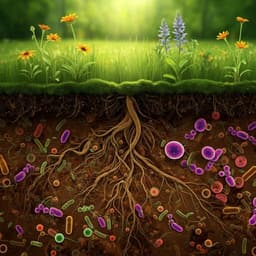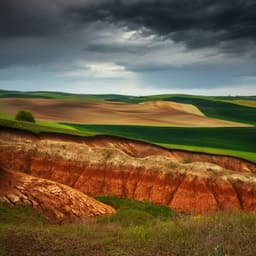
Environmental Studies and Forestry
Soil inoculum identity and rate jointly steer microbiomes and plant communities in the field
X. Han, Y. Li, et al.
Explore how soil from different ecosystems can rejuvenate degraded habitats and influence biodiversity. This exciting research by Xu Han, Yingbin Li, Yuhui Li, Xiaofang Du, Bing Li, Qi Li, and T. Martijn Bezemer uncovers the pivotal role of soil inoculum identity and quantity in restoring ecological balance.
~3 min • Beginner • English
Introduction
The study addresses how soil inoculation from different donor grasslands and at varying inoculum amounts influences belowground microbiomes and aboveground plant communities in a degraded grassland. Grasslands, which cover ~40% of Earth’s surface, are widely degraded due to land-use intensification, compromising biodiversity and ecosystem services. Soil organisms drive key processes such as decomposition and nutrient cycling and can influence plant community dynamics. Prior work shows that soil inoculation from later-successional or semi-restored sites can steer recipient soil and plant communities toward target states, but open questions remain: whether donor soils from similar ecosystem types but different plant communities steer trajectories differently; how much soil inoculum is required in field settings over multiple years; and whether smaller amounts could suffice due to positive plant–soil feedbacks. The authors hypothesized: (H1) inoculation with different donor grassland soils (meadow steppe vs upland meadow) would steer soil microbiomes and plant communities toward their respective donor communities; (H2) upland meadow soil would lead to better restoration than meadow steppe due to higher biodiversity in the forest–steppe ecotone; and (H3) effects of soil inoculation would increase with inoculum amount.
Literature Review
Previous studies show that transferring topsoil or inoculating with soil from late-successional ecosystems can alter soil microbiota and facilitate target plant establishment (e.g., Wubs et al. 2016; Middleton & Bever 2012). Evidence indicates that distinct donor ecosystems can cause different changes in recipient soil and plant communities. However, amounts of donor soil used vary widely (from millimeters to decimeters of soil), and controlled pot studies suggest positive relationships between inoculum quantity and plant biomass, while the long-term field dose–response remained unclear. The potential for small inoculum amounts to have similar long-term effects through self-reinforcing plant–soil feedbacks had not been tested comprehensively. In restoration, minimizing donor area disturbance underscores the need to identify effective minimal inoculum rates.
Methodology
Experimental design and site: The field experiment was conducted at a degraded grassland near the Erguna Forest-Steppe Ecotone Research Station, Chinese Academy of Sciences (50°10′46.1″N, 119°22′56.4″E). Mean annual temperature −2.4 °C (−28 °C January min; 19.1 °C July max); mean annual precipitation 361.6 mm; surface soil (0–10 cm) texture ~47% sand and 51% clay+silt. In 2018, two donor grasslands within ~20 km were selected: a meadow steppe (moderate disturbance via annual mowing; xerophytic grasses) and an upland meadow (forest–steppe ecotone; little disturbance; mesophytic forbs). Soil types: chernozems (recipient and meadow steppe) and chernozems or kastanozems (upland meadow) per WRB.
Donor soil collection and inoculation: For each donor, three replicate sites (~1 km apart) were selected. From May 21–29, 2018, vegetation was removed and the top 10 cm soil was excavated and homogenized at each donor site, then transported by truck. At the recipient site, the top 5 cm was removed in 2×2×0.05 m blocks and discarded to facilitate restoration. Plots (2×2 m; 2 m paths) received donor soil at three depths: 1 cm, 3 cm, 5 cm, corresponding to 10, 30, 50 L m−2. Bulk densities used: meadow steppe 1.34 g cm−3; upland meadow 1.13 g cm−3. Soil was weighed and compacted to reach target depths. A control (topsoil removal without inoculation) was included. Design: three replicated blocks; 19 plots per block (2 donor types × 3 donor site replicates × 3 depths + control) for 57 plots total. Central 1×1 m quadrat for vegetation; rotating 0.25×0.25 m quadrats for destructive sampling.
Sampling timeline: August 2018, 2019, 2020. In 2018, all 57 plots analyzed for soil properties, plant and nematode communities; for 2018 bacterial/fungal sequencing, soil was homogenized between blocks (except controls) resulting in 21 samples sequenced; in 2019 and 2020 all 57 plots sequenced for microbial communities. In 2020 donor site soils and vegetation were also sampled.
Soil sampling and physicochemical analysis: Ten soil cores per plot (2.5 cm diameter, 10 cm depth) pooled; roots removed. Subsamples: 10 g at −80 °C for DNA; ~100 g at 4 °C for nematodes; remainder air-dried after 2 mm sieving. Soil moisture by drying at 105 °C for 24 h; pH in 1:2.5 soil:water; total C and N by TruSpec CN analyzer; total P by molybdenum–antimony colorimetry (spectrophotometer).
DNA extraction and amplicon sequencing: DNA from 0.5 g soil (FastDNA Spin Kit). Bacterial 16S rRNA V4 amplified with 515F/907R; fungal ITS2 with ITS86F/ITS4R. PCR: 10 ng template in 20 μl with FastPfu components; 95 °C 3 min; bacteria 27 cycles, fungi 35 cycles of 95 °C 30 s, 55 °C 30 s, 72 °C 45 s; final 72 °C 10 min. Sequencing on Illumina MiSeq PE300 with PhiX. Bioinformatics: FLASH merge, USEARCH barcode/primer removal, FASTP quality filter, UPARSE OTU clustering at 97% similarity, taxonomy via RDP classifier; bacterial taxonomy with SILVA 138, fungal with UNITE 8.0. OTUs occurring in <3 samples or <0.01% relative abundance were removed. Rarefaction to 19,067 (bacteria) and 59,331 (fungi) reads. Data deposited at China National Microbiology Data Center (NMDC10017881).
Nematodes: Extracted from 100 g fresh soil via modified cotton-wool filter method with 250 μm and 38 μm sieves, settled 24 h, fixed in 4% formaldehyde. Total counts by stereomicroscope; ≥100 individuals identified to genus by compound microscope.
Plant community: Each August 2018–2020, species richness and percent cover by species recorded in 1×1 m quadrat. Aboveground biomass clipped at 1 cm in adjacent quadrat; in 2020 belowground biomass assessed from three 5 cm diameter, 10 cm deep cores; roots washed on 2 mm sieve. Biomass dried at 60 °C to constant mass. Species categorized as annual or perennial; ratio of perennial cover to total cover calculated. Indicator species defined for degraded sites, meadow steppe, and upland meadow; Leymus chinensis targeted. Target species sets: meadow steppe (L. chinensis, Stipa capillata, Koeleria cristata); upland meadow (L. chinensis and mesophytic forbs including Sanguisorba officinalis, Artemisia tanacetifolia, Vicia sepium, Trifolium lupinaster, Lathyrus quinquenervius, Galium verum, Carex pediformis).
Statistical analyses: R 3.6.1. Univariate responses (soil properties, soil biota, plants) analyzed with linear mixed models (lmer, lme4). Repeated-measures models assessed effects of year, soil type (donor identity), inoculum amount, and interactions, with block and donor site replicate as random effects; post hoc Scheffé tests (glht, multcomp). For 2020, response ratios RR=(Xt−Xc)/Xc computed relative to control and each donor; mixed models tested effects of soil type, amount, and interaction with block and site replicate as random effects.
Community composition: Bray–Curtis PCoA ordinations for bacteria, fungi, nematodes, and plants; PERMANOVA (adonis2, vegan) tested effects. Plant cover Hellinger-transformed. 2020 ordinations included donor sites; pairwise similarity to control and donors computed as 1−Bray–Curtis; mixed models assessed soil type and amount effects on similarity.
Differential genera and networks: OTUs agglomerated to genera for cross-kingdom comparisons. Genera significantly increased in inoculated plots vs controls identified by indicator species analysis (indicspecies) and edgeR LRT with FDR correction (Benjamini–Hochberg, P<0.05). Co-occurrence networks built using Spearman correlations among bacterial, fungal, and nematode genera (r>0.6, P<0.001) after centered log-ratio transformation; visualized with igraph (Fruchterman–Reingold; 10 permutations). Network complexity quantified as linkage density; compared to random Erdos–Renyi networks. Top 10 central (highest degree) genera identified; Spearman correlations with inoculum amount and soil/plant traits evaluated.
Key Findings
- Donor identity and inoculum amount effects: Both donor soil identity and inoculum amount significantly affected bacterial, fungal, nematode, and plant community composition across years (PERMANOVA). Table 1 (R², F, P): Year effects were strong for all groups (e.g., Plants: R²=0.262, F=71.64, P<0.001). Soil identity significant for all (Bacteria R²=0.068, F=10.53; Fungi R²=0.051, F=7.33; Nematodes R²=0.029, F=5.41; Plants R²=0.071, F=19.48; all P<0.001). Amount significant for Bacteria (R²=0.046, F=3.55, P<0.001), Fungi (R²=0.029, F=2.09, P<0.001), Nematodes (R²=0.020, F=1.91, P=0.008), and Plants (R²=0.049, F=6.7, P<0.001). Soil×Amount interaction significant for Bacteria (R²=0.027, F=2.07, P<0.001), Fungi (R²=0.021, F=1.51, P=0.016), and Plants (R²=0.007, F=4.18, P<0.001).
- Trajectory toward donors and dose response: By year 3, bacterial and fungal communities in inoculated plots diverged toward their respective donors, with divergence increasing with inoculum amount. Nematode community effects were limited in year 1 but significant in years 2–3.
- Diversity changes: Increasing inoculum amount increased fungal richness (F=15.26, P<0.001) but reduced bacterial richness (F=3.21, P=0.044). Bacterial richness was lower with upland meadow inoculum than meadow steppe (F=5.6, P=0.02).
- Plant community responses: Plant community composition shifted toward donor communities; proportional cover of perennials increased over time (F=168.82, P=0.006) and was higher with upland meadow inoculation than meadow steppe (F=92.57, P<0.001). Plant species richness increased with inoculum amount and was higher in upland meadow–inoculated plots. Inoculation suppressed degraded-site indicator species and increased relative cover/abundance of target Leymus chinensis. Total cover of target species increased over time (meadow steppe: F=92.4, P=0.011; upland meadow: F=79.37, P=0.012) without significant effect of amount. More upland meadow target species colonized after upland meadow inoculation (F=15.62, P<0.001); meadow steppe target species did not colonize more successfully than in controls.
- Biomass and soil properties: In year 3, belowground biomass was higher in inoculated vs control plots (F=11.74, P<0.01), increasing with inoculum amount (F=11.60, P<0.001); aboveground biomass was not significantly affected (soil: F=0.41, P=0.53; amount: F=0.26, P=0.77; soil×amount: F=0.58, P=0.56). Soil nutrients and moisture increased with inoculum amount.
- Similarity analyses (year 3): With increasing inoculum amount, inoculated plots became more dissimilar from controls for bacteria and plants. Meadow steppe inoculation increased similarity to meadow steppe donor for bacteria and fungi; amount had positive effects for both. Upland meadow inoculation increased similarity to upland meadow donor for fungi and plants; amount had positive effects for bacteria, fungi, and plants.
- Network properties and key taxa: Genera with higher relative abundance in inoculated plots vs controls were identified. Co-occurrence networks were more complex after upland meadow inoculation (linkage density 2.12) than meadow steppe inoculation (1.58). Nine of the top ten central genera increased after upland meadow inoculation and positively correlated with inoculum amount; only two central genera increased after meadow steppe inoculation. Central genera (e.g., Massilia, Mucilaginibacter) correlated positively with soil and plant traits, suggesting roles in microbiome functioning and restoration trajectories.
Discussion
The findings demonstrate that both the origin and the amount of donor soil steer the development of soil microbiomes and plant communities in degraded grassland. Even within the same broad ecosystem type (grasslands), donor soils from different plant community contexts (meadow steppe vs upland meadow) induced divergent trajectories, underscoring the need to carefully select donor sites aligned with restoration targets. Upland meadow inoculation produced stronger shifts in plant communities and introduced more central taxa in soil biotic networks, leading to more complex network structures, which may enhance ecosystem functioning.
The approximately linear increase in community divergence and donor similarity with inoculum amount supports a dose–response effect (H3). Likely mechanisms include higher densities of seeds, root fragments, and soil organisms, improved microenvironmental buffering (e.g., moisture, nutrients, pH) with thicker inoculum layers, and density-dependent functions and survival of introduced soil biota. The stronger plant community response to upland meadow inoculum suggests differences in propagule availability and/or compatibility with local conditions and biotic interactions. Central bacterial taxa correlated with plant and soil traits may facilitate early plant growth and nutrient cycling, further reinforcing restoration trajectories.
Temporal dynamics showed that effects strengthened over three years, with delayed responses in higher trophic levels (nematodes), indicating that inoculation initiates new community assembly rather than transient carry-over. The results highlight whole-soil inoculation as a close-to-nature restoration tool capable of reshaping entire soil food webs and above–belowground linkages in the field.
Conclusion
This three-year field experiment shows that soil inoculum identity and inoculation rate jointly and predictably steer belowground microbiomes and aboveground plant communities in degraded grassland. Donor identity matters: upland meadow soil produced stronger plant community shifts, more complex soil biotic networks, and introduced more central genera than meadow steppe soil. Inoculum amount exhibits a positive, near-linear dose–response, enhancing similarity to donor communities and increasing belowground biomass and soil resources.
These findings advance restoration ecology by demonstrating that targeted selection of donor soil and optimizing inoculum amounts can accelerate and direct ecosystem recovery. Future research should: (1) disentangle effects of soil biota vs plant propagules by factorial designs manipulating seeds and soil inocula; (2) conduct long-term monitoring to determine whether small-inoculum treatments eventually converge with high-inoculum outcomes or revert toward controls; (3) examine different degradation levels to guide inoculum amount recommendations; and (4) identify and test roles of central taxa in engineered microbial consortia to further enhance restoration effectiveness.
Limitations
The study did not explicitly separate the effects of introduced plant propagules (seeds, root fragments) from those of soil biota in the field, making it difficult to attribute plant community changes solely to microbial mechanisms. Early sequencing in 2018 used homogenized samples across blocks (reducing within-treatment replication for that year), and donor soil collection inherently disturbs donor sites, highlighting practical constraints. The three-year duration, while informative, is insufficient to resolve long-term convergence/divergence of trajectories, especially for slow-growing, low-dispersal soil taxa and above–belowground feedbacks.
Related Publications
Explore these studies to deepen your understanding of the subject.







